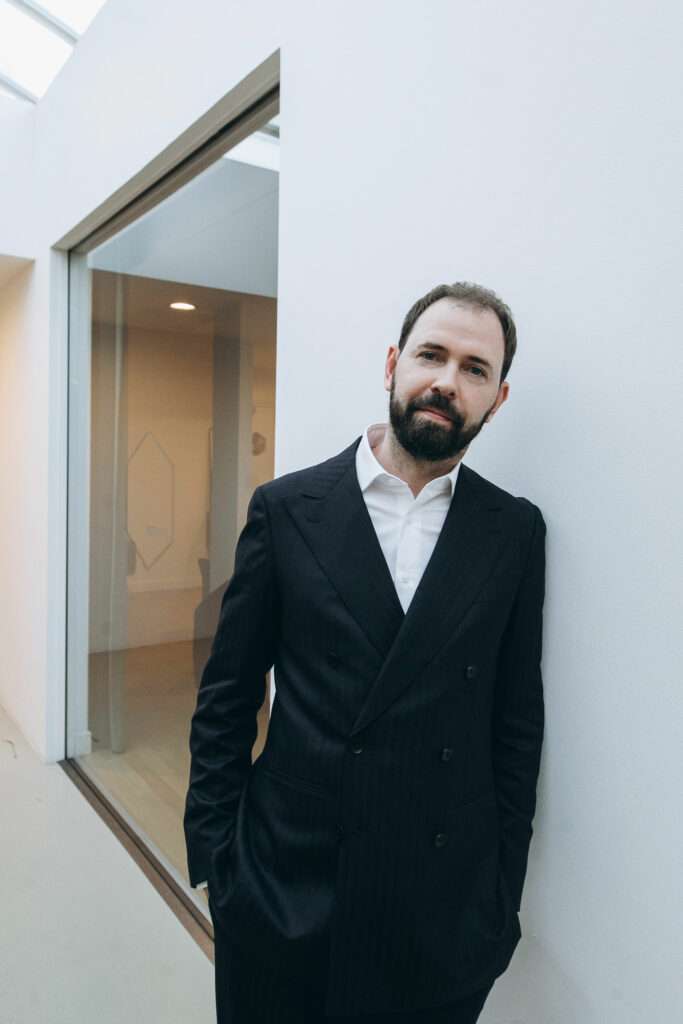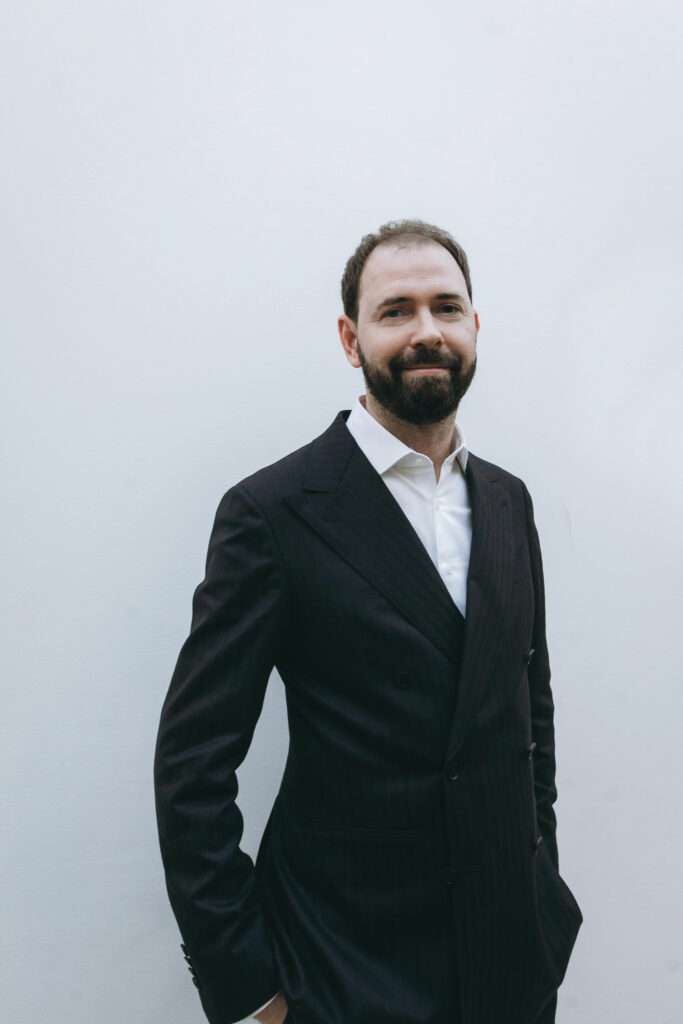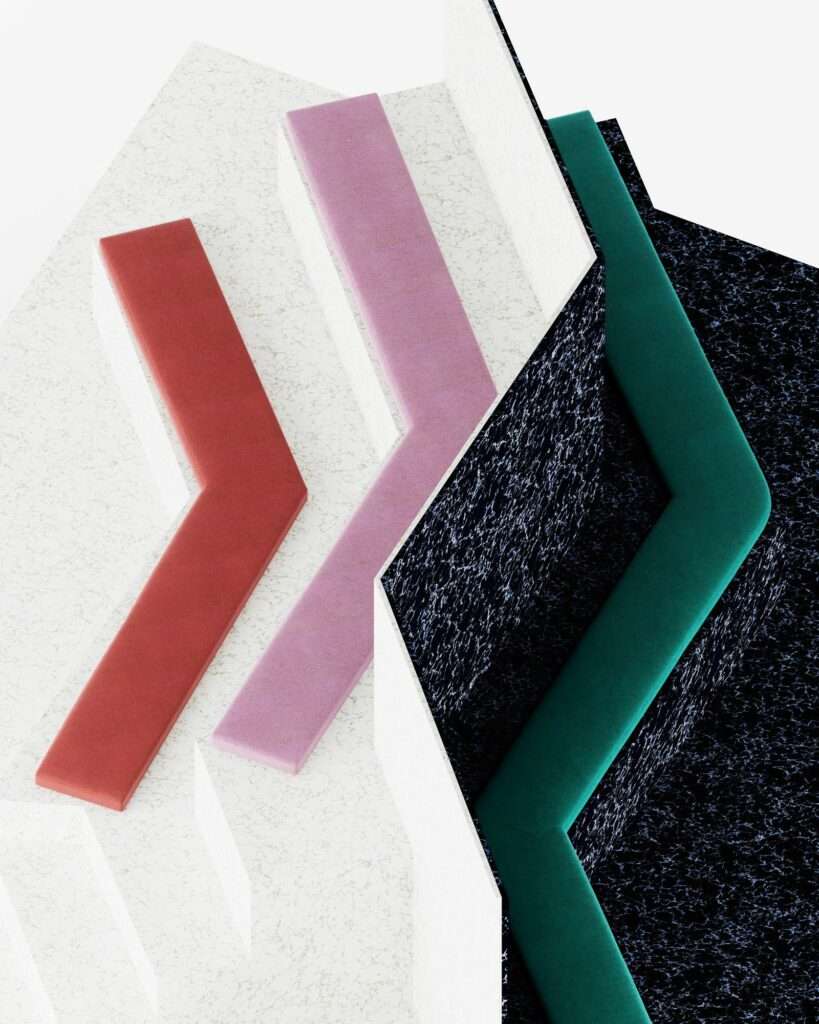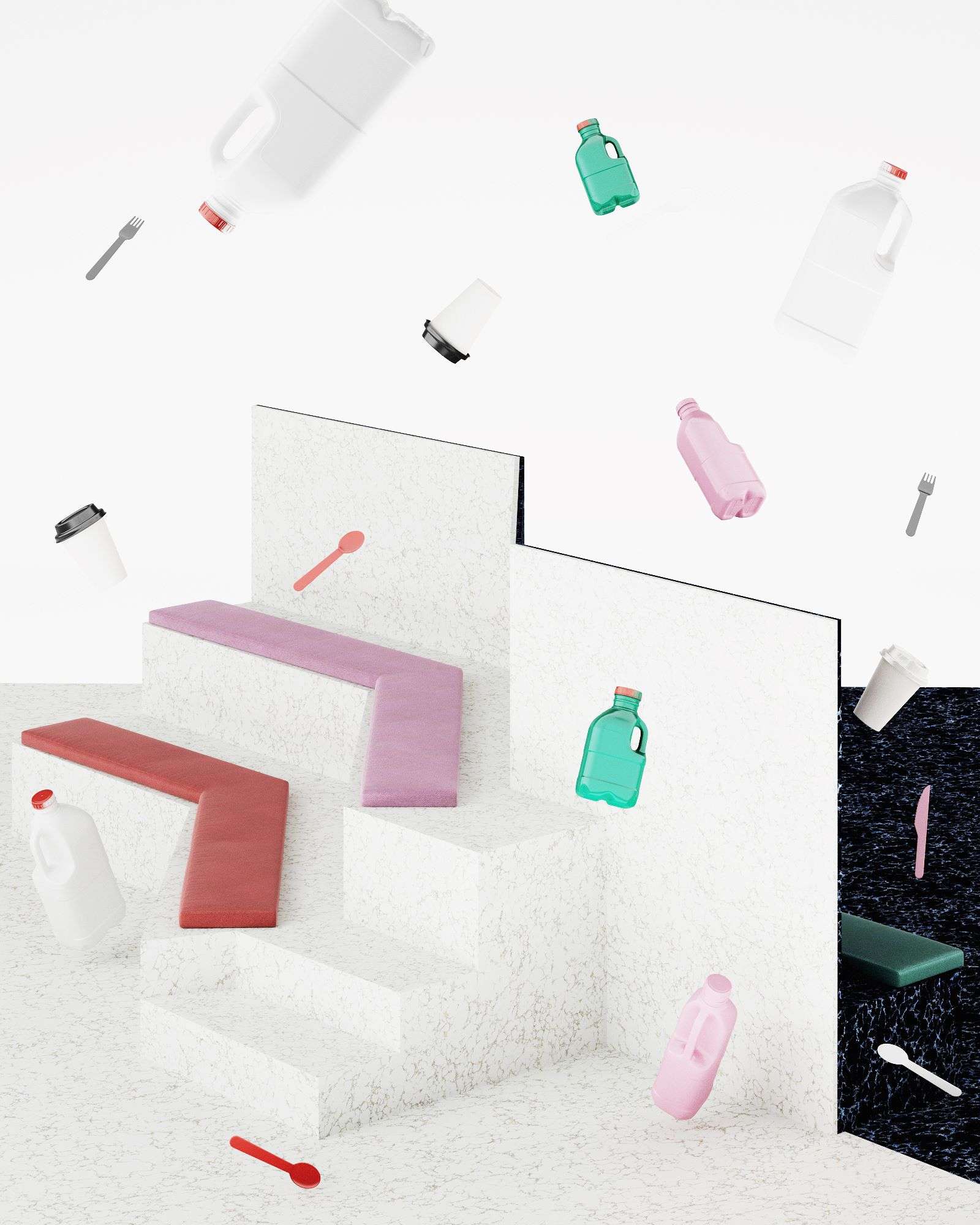Header: Renders by STUDIO SHOO.
Dr. William Chizhovsky, the visionary founder and CEO of The Good Plastic Company, is leading the charge to turn plastic waste into something purposeful. With over seven years of experience in international trade, business development, and leadership, he’s committed to transforming industries and the environment through sustainable innovation.
In this interview, we explore his journey, the impact of his company, and an exciting collaboration between Kvadrat, STUDIO SHOO, and the Good Plastic Company—a thought-provoking lounge installation, “From the Fridge,” at Dubai Design Week. Crafted from 100% recycled and recyclable Polygood® plastic panels sourced from discarded refrigerator plastics and featuring Kvadrat’s Sport upholstery fabric made from ocean-bound plastic, this installation challenges our perception of waste.
The future of design is green, and it’s happening now. Don’t miss the full interview with Dr. Chizhovsky below!

What inspired you to focus on tackling the global plastic waste challenge?
I’ll start by sharing four shocking statistics on plastic pollution.
First, almost 2/3 of all plastic waste comes from applications with life spans of less than five years: packaging (40%), consumer products (12%), and textiles (11%).
Second, of all plastic waste ever produced, as little as 9% is recycled.
Third, about eight million tons of plastic waste escapes into our oceans — that’s about five trash bags lining every foot of coastline around the world.
Finally, plastic production has increased exponentially, from 2.3 million tons in 1950 to 448 million tons by 2015. Production might also double by 2050.
These facts were my biggest motivating factor. But making small items like bracelets or glasses frames from plastic waste, while admirable, couldn’t address the sheer volume of the problem.
We needed something far more ambitious – a process that could tackle the massive challenge of plastic waste and transform it into valuable materials.
How does The Good Plastic Company ensure that its recycled materials, like Polygood®, maintain high-quality standards while remaining eco-friendly?
First, it’s about conscious sourcing. We obtain recycled plastic exclusively from certified companies who specialise in recycling polystyrene, the sole material used to make our Polygood® panels. With this third-party auditing system, we are guaranteed transparency around the origin of waste in plastics recycling processes, the process put in place, and the required permits to ensure operations are environmentally sound.
Next, using a single ingredient for our panels is crucial. Polygood® is made from a single type of recycled polystyrene (rPS). It helps that rPS is abundant and inherently durable, for long-wearing use. But not mixing ingredients allows the material to be repeatedly recycled and reused, closing the loop on plastic waste — a cornerstone of true circular economy principles.
We’ve also undergone rigorous auditing to achieve several key certifications that validate our quality and environmental standards: Cradle to Cradle Certification®, an Environmental Product Declaration, and a VOC+ rating for nonhazardous materials. Our manufacturing process follows ISO 14001 for Environmental Management, ISO 9001 for Quality Management, and ISO 45001 for Occupational Health and Safety.
Through our Take-Back Programme, we ensure that every panel we produce can be recycled again at the end of its life for free. No panel ever has to be thrown away.
What do you believe are the most significant challenges facing the recycling industry today, and how can AI help address them?
The plastic recycling industry faces numerous challenges: inefficient sorting processes, contamination of waste streams, cost, and the complexity of recycling mixed plastics. These challenges result in low recycling rates and underutilization of plastic waste, which perpetuates environmental pollution.
Machine learning models could one day predict waste generation patterns and optimise collection processes – imagine municipalities and recycling companies planning their operations with unprecedented precision. AI is even being explored for microplastic removal from ecosystems.
I would hope to see in my lifetime AI tools that automate and optimise recycling processes, improving material recovery rates while reducing operational costs. AI driven frameworks could provide data-driven recommendations for handling, recycling, and disposal – exactly the kind of scalable solutions we need to tackle plastic pollution at an industrial level.
How do you see AI contributing to the future of sustainable material innovation, particularly in the context of your work with recycled plastics?
AI technology opens exciting possibilities for sustainable material development. In our field, we see potential for AI to advance recycling processes and create innovative applications for recycled materials. Machine learning could help optimise material formulations and predict how different recycled inputs might combine to create new aesthetic and functional properties. This technology could also help scale sustainable material production while maintaining consistent quality – crucial for widespread adoption in architecture and design.

The global plastic waste crisis is a growing concern. What role do you believe design and technology can play in mitigating this problem?
The role of design in this context goes beyond aesthetics. It’s about rethinking entire systems. When designers specify recycled materials for large-scale projects, they’re not just making a style choice – they’re helping to create market demand for recycled materials, which in turn encourages more investment in recycling infrastructure and technology.
The better the technology, the more scalable reusing existing materials like plastic will be. And because the circular economy begins at the design phase of any product or project, technologically advanced materials can drive good design.
What steps do you think the design industry should take to further integrate sustainability into their practices?
Embrace circular design principles and design for longevity. This means designing with the end in mind – considering how materials can be reused or recycled from the start. Products should be designed for extended use, with durability and repairability in mind. This includes modular designs that allow for easy upgrades and replacements of parts. Choose products that already exist. Choose companies that have a Take-Back Programme, so materials can be reused again. This kind of closed-loop thinking needs to become standard practice.
Prioritise materials with proven sustainability credentials. Look for certifications like Cradle to Cradle® and Environmental Product Declarations. Obtain wood with an FSC forest-management certification.
Leverage technology in the design process. Use digital LCA tools to assess environmental impact. Specify materials that have a digital product passport or incorporate innovative recycling technologies.
Explore the power of collaboration. Through our work, companies approach us with their own plastic waste streams. We can test and potentially incorporate these into new materials. This kind of collaborative approach, enhanced by technology, could help create more closed-loop systems across industries.
How do you see collaborations between material companies, like yours, and tech companies driving forward sustainability in design?
I see exciting areas where material companies and tech companies can create powerful synergies:
AI algorithms are also enhancing LCA tools, allowing for more precise assessments of a material’s environmental impact from production to disposal. This helps architects and engineers make data-informed decisions that align with sustainability goals.
Looking to the future, I’m particularly excited about:
- AI-Enhanced Recycling Processes: Leveraging AI to improve the recycling of construction and demolition waste, creating new materials from old structures.
- Digital Twins for Sustainability: Using AI and digital twin technology to simulate and optimise building material performance over time.
- Green Certifications: AI can support compliance with green building standards (like LEED or BREEAM) by providing accurate data on the sustainability of materials used.
As AI develops, how do you envision it being used to develop new materials that are both sustainable and high-performance?
I would like to see developments in the reuse of existing materials primarily, saving virgin materials of all kinds. So in that sense, AI-powered tools could help optimise mechanical properties of recycled materials, potentially leading to the design of sustainable replacements for conventional construction materials. For instance, AI-driven models can help determine the best mix ratios for incorporating industrial by-products like fly ash, slag, or recycled glass into concrete, thereby reducing the carbon footprint.
How important is it for designers to embrace AI in their sustainable design process, and what benefits does it bring to the table?
The benefits could be substantial. For instance, AI could help designers better understand the environmental impact of their material choices. In our case, we know that our process emits several times less CO2 than virgin plastic production or that of competing surface materials. AI could help designers optimise their material selections even further, perhaps finding new ways to reduce environmental impact while maintaining design integrity. And since buildings have lifespans lasting decades, modular components and sustainable choices can prolong the life of the interior fixtures for that duration — and therefore long-term costs for clients.
Could you share more about the “From the Fridge” installation at Dubai Design Week and how it showcases the potential of recycled plastics in art and design?
The concept is beautifully simple yet profound: we took recycled refrigerator panels – typically seen as bulky waste – and transformed them into sophisticated design elements.
“From the Fridge” is an installation of tiered seating that is made from two of my favourite Polygood® patterns: Sea Foam Grey and SeaFoam Dark. Refrigerators and white spools make the base colours of both. But the marbling you see is reused plastic shavings from our own CNC cutting machines. Nothing is wasted!
And that’s the beauty of making attractive seating like that through the imaginative use of everyday materials. Look what is possible. This was imagined by designers at Studio Shoo, who worked with our Middle East distributor, Danube, to make a statement about rethinking global environmental challenges and advancing towards a more sustainable future.
The installation shows that recycled plastic isn’t just a substitute for traditional materials – it’s a design material in its own right, capable of creating striking aesthetic experiences.


What’s your message to young designers entering the field about incorporating sustainability into their creative practices?
My message to young designers is this: you’re entering the field at a transformative moment. The industry needs fresh thinking about how we can create a circular economy. I enjoy seeing budding creatives at the design fairs we attend, making amazing things out of mycelium, leaves, leather scraps, and of course, all forms of recycled plastic.
The global community is now moving toward creating international agreements to control virgin plastic production, similar to how we tackled ozone-depleting substances. This means the future of design will increasingly focus on recycled and sustainable materials. Your generation has the opportunity to be at the forefront of this transformation.
For young designers, I encourage you to:
- Challenge conventional thinking about materials
- Look at waste streams as potential resources
- Consider the entire lifecycle of your designs
- Think about scalability – how can solutions work in practice
- Use recycled materials when using 3D printers
The world needs creative minds who can envision new possibilities for the materials we already have. Remember, every piece of “waste” is just a resource waiting for the right application.
Photos Courtesy of The Good Plastic Company and Dr. William Chizhovsky. The renders for From the Fridge were created by STUDIO SHOO, https://studioshoo.com.










